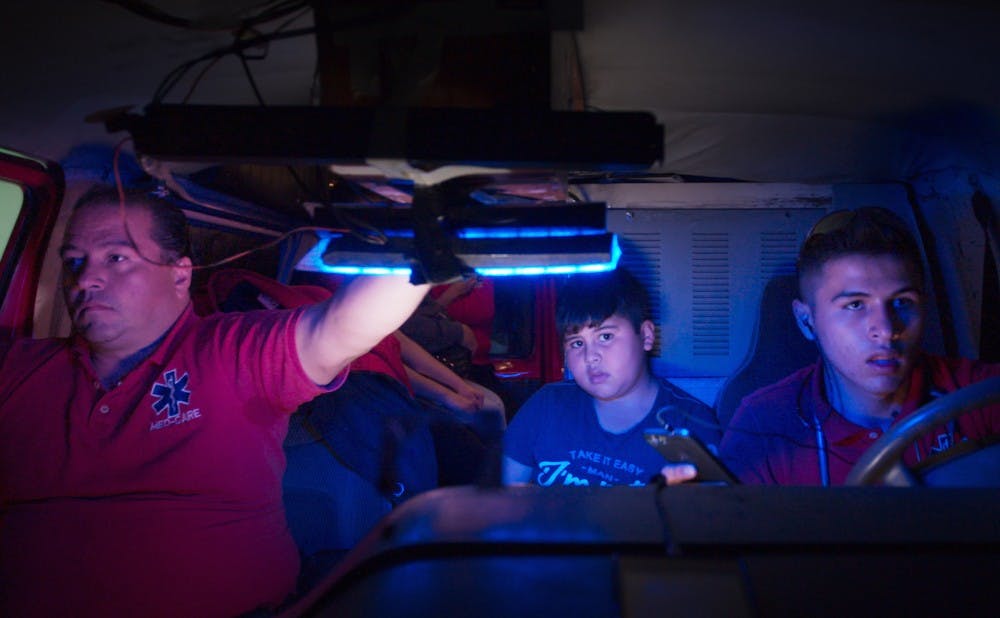"Midnight Family" follows the Ochoa family, who runs a private ambulance company in Mexico City. Nine million people reside there, but less than 45 government ambulances are running, according to the film. Luke Lorentzen shot and directed the film over a three-year period, and he stayed with the Ochoa family for some 80 to 90 nights in their private ambulance. “Midnight Family” screened at Full Frame Documentary Film Festival after premiering at Sundance earlier this year and winning the U.S. Documentary Special Jury Award for Cinematography. The Chronicle spoke with Lorentzen about the Ochoa's business and documenting crisis. This interview has been edited for length and clarity.
The Chronicle: How did you find yourself in the situation with the Ochoa family?
Luke Lorentzen: I moved to Mexico City, right after graduating college, with a really good friend who grew up there most of his life. I met the Ochoa family just parked in front of my apartment building. I was curious enough to ask them if I could ride along for the night, and in that first experience, I saw this whole underground world of for-profit ambulances that chase each other to accidents and was pretty immediately hooked and excited about making a film about it.
TC: Did you get pretty close with the Ochoas?
LL: Yeah, I really did. When I’m making a movie like this, I really think that my primary job is to get to know the people I’m filming and really build a connection with them. I’m still kind of trying to keep my objectivity — whatever that means — but it’s really about making sure that I can get into their world and feel that what I’m filming is authentic to who they are. And that took nights and nights and even months before I got there, but that’s kind of why it took so long. The film really depended on that intimacy for it to work properly.
TC: There are some moments where it could almost seem like they were filming themselves because you were so close to them. What did you learn from them?
LL: A lot of different things. I think they are really interesting examples of people who may not always have the luxury to do the best thing. They’re operating in this incredibly broken and corrupt system without the resources to fix it themselves. So they’re kind of forced into these really difficult situations where right and wrong is blurred, and they kind of need to choose between themselves and the people they treat. It’s this really tricky place where no one is getting what they need to survive. The film is really about where personal responsibility fits into this web of government dysfunction. They gave me a really profound perspective on the burden of trying to be a good person in a world that pushes you elsewhere.
TC: How did the Ochoa family start this business?
LL: The father of the family was working as a bouncer at a nightclub and he got to know a bunch of people that worked for their Mexican Red Cross. He ended up working with them for about ten years and learned about the healthcare system in Mexico, and then thought that he should try opening up his own business. They actually bought a retired ambulance from Oklahoma that they repurposed and made their own, and started to respond to accidents.
TC: It was definitely hard to watch at some moments. How was that for you to be there during those times of crisis and how do you think people have responded to that?
LL: It was something that took a long time to learn how to do properly. When I started filming in the ambulance, I was actually only filming with the camera on the dashboard, trying to tell the story without ever even showing patients or what was happening in the back of the ambulance. I slowly learned that that wasn’t going to quite capture the full emotional spectrum of the Ochoas’ experiences and expanded the ways in which I was filming. But I always had a pretty sensitive take on what I would film and what I wouldn’t when it came to patients. None of the patients’ faces are revealed, which wasn’t necessarily something we had to do for legal reasons, but was more something we wanted to do to protect their privacy and also to tell the viewer that they were going to be in good hands, that we were going to take them to really difficult places but we weren’t going to abuse that, if that makes sense.
But about half of the accidents that I showed up to were things that I couldn’t film, or didn’t film because somebody asked me not to or I just didn’t feel comfortable. The last accident in the film, which I think is the most difficult one to watch, was something that was filmed really early on in the process, and it was footage that I almost deleted because it wasn’t something that I thought I should’ve filmed, but I kept it and eventually showed it to an old professor of mine who encouraged me to go and find the mother that that had happened to. So like six months after that accident had happened, I went and knocked on her door. I spent a couple of hours talking to her about the film and it turned out that her daughter, who passed away, was studying journalism, and she felt that the film was something that they would want to participate in. So that’s kind of one example of it being a process of figuring out how to get people’s permission and how to include that.
Get The Chronicle straight to your inbox
Sign up for our weekly newsletter. Cancel at any time.

